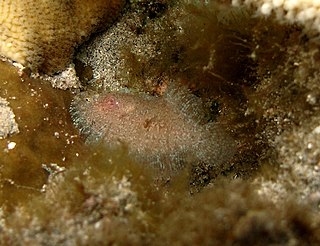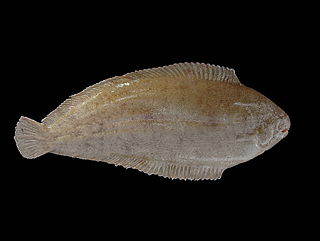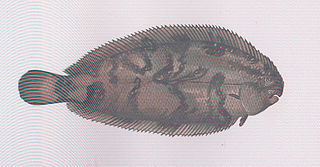
A flatfish is a member of the ray-finned demersal fish order Pleuronectiformes, also called the Heterosomata, sometimes classified as a suborder of Perciformes. In many species, both eyes lie on one side of the head, one or the other migrating through or around the head during development. Some species face their left sides upward, some face their right sides upward, and others face either side upward.

The American soles are a family (Achiridae) of flatfish occurring in both freshwater and marine environments of the Americas. The family includes about 35 species in seven genera. These are closely related to the soles (Soleidae), and have been classified as a subfamily of it, but achirids have a number of distinct characteristics.

Pleuronectidae, also known as righteye flounders, are a family of flounders. They are called "righteye flounders" because most species lie on the sea bottom on their left sides, with both eyes on their right sides. The Paralichthyidae are the opposite, with their eyes on the left side. A small number of species in Pleuronectidae can also have their eyes on the left side, notably the members of the genus Platichthys.

Demersal fish, also known as groundfish, live and feed on or near the bottom of seas or lakes. They occupy the sea floors and lake beds, which usually consist of mud, sand, gravel or rocks. In coastal waters they are found on or near the continental shelf, and in deep waters they are found on or near the continental slope or along the continental rise. They are not generally found in the deepest waters, such as abyssal depths or on the abyssal plain, but they can be found around seamounts and islands. The word demersal comes from the Latin demergere, which means to sink.

Tonguefishes are flatfish in the family Cynoglossidae. They are distinguished by the presence of a long hook on the snout overhanging the mouth, and the absence of pectoral fins. Their eyes are both on the left side of their bodies, which also lack a pelvic fin. This family has three genera with a total of more than 140 species. The largest reaches a length of 66 cm (26 in), though most species only reach half that size or less. They are found in tropical and subtropical oceans, mainly in shallow waters and estuaries, though some species are found in deep sea floors, and even a few in rivers.

The common sole, Dover sole, or black sole is a species of flatfish in the family Soleidae. It is one of the largest fish in the Solea genus. It lives on the sandy or muddy seabed of the northern Atlantic and the Mediterranean Sea where it often semi-immerses itself in the substrate. The upper side is greyish-brown while the underside is white. It grows to a maximum length of about 70 cm (28 in). The species is prized as a food fish, being caught mostly by trawling on the seabed.

Samaridae is a family of crested flounders, small flatfishes native to the Indo-Pacific. The family contains four genera with a total of 29 species.

The solenette or yellow sole, Buglossidium luteum, is a species of flatfish in the family Soleidae, and the only member of its genus. It is characterized by its small size, low-slung semi-circular mouth, and regularly placed dark fin rays. A common and widespread species, it is native to sandy bottoms in the northeastern Atlantic Ocean and the Mediterranean Sea. It is of little commercial value.

The Pacific sand sole, also known as simply sand sole, is a flatfish species inhabiting the northeastern Pacific waters where it lives on sandy bottoms. The only species in the genus, Psettichthys, it ranges from the Bering Sea to Northern California.

Plaice is a common name for a group of flatfish that comprises four species: the European, American, Alaskan and scale-eye plaice.

The wedge sole, is a flatfish of the family Soleidae. It is a bottom dwelling predatory fish inhabiting both sandy and muddy soils at depths between 10 and 450 m in the East Atlantic and Mediterranean Sea. It achieves a maximum size of 30 cm (12 in).

Aseraggodes is a genus of soles native to the Indian and Pacific oceans. These small flatfishes are poisonous.

Solea is a genus of soles from the Indo-Pacific and East Atlantic Oceans, and the Mediterranean Sea.

Zebrias is a genus of ray-finned fish in the family Soleidae.

The sand sole is a fish species in the family Soleidae. It is a marine, subtropical, demersal fish up to 40 centimetres (16 in) long.

The Egyptian sole is a species of flatfish in the true sole family, Soleidae. It lives on the sandy or muddy seabed of the Mediterranean Sea, and is now colonising the Red Sea. It often semi-immerses itself in the substrate. The upper side is greyish-brown while the underside is white. It grows to a maximum length of about 70 cm (28 in). This fish is used for human consumption and is prized as a food fish. It is caught mostly by trawling on the seabed.

The ovate sole is a species of flatfish in the true sole family, Soleidae native to the Indo-Pacific. Solea ovata has eyes on the right side with small scales on the sides of its body (ovata). The total length of its mitogenome is 16,782 bp with 13 protein-coding genes, 22 tRNA genes, and 2 rRNA genes. The organism, Solea Ovata was found in Guangdong province, China. Solea Ovata are usually found in shallow sand and mud at the bottom of water throughout the coast of Indo-Pacific ocean.
The tufted sole is a species of flatfish from the family of true soles Soleidae. It is the only species in the monotypic genus Dexillus. It is found in the Indian and western Pacific Oceans.

Solea senegalensis, the Senegalese sole, is a species of flatfish from the family of the true soles, the Soleidae, from the eastern Atlantic and the Mediterranean Sea.

The thickback sole, also known as the bastard sole and lucky sole, is a species of flatfish from the family of true soles, the Soleidae. It is found in the eastern Atlantic Ocean and the Mediterranean Sea, it is a quarry for fisheries in the Mediterranean.

























